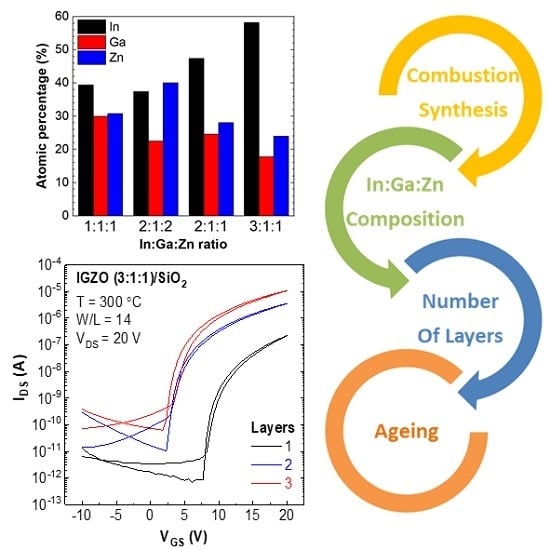Tailoring IGZO Composition for Enhanced Fully Solution-Based Thin Film Transistors
Abstract
:1. Introduction
2. Experimental Section
2.1. Precursor Solution Development and Characterization
2.2. IGZO Film Deposition and Material Characterization
2.3. TFTs/Devices Fabrication and Characterisation
3. Results and Discussion
3.1. Precursor Solutions and Thin Films Characterization
3.2. Electrical Characterization of IGZO Thin Film Transistors (TFTs)
4. Conclusions
Supplementary Materials
Author Contributions
Funding
Acknowledgments
Conflicts of Interest
References
- Hosono, H. Ionic amorphous oxide semiconductors: Material design, carrier transport, and device Application. J. Non. Cryst. Solids 2006, 352, 851–858. [Google Scholar] [CrossRef]
- Nomura, K.; Ohta, H.; Takagi, A.; Kamiya, T.; Hirano, M.; Hosono, H. Room-temperature fabrication of transparent flexible thin-film transistors using amorphous oxide semiconductors. Nature 2004, 432, 488–492. [Google Scholar] [CrossRef] [PubMed]
- Lee, W.; Choi, S.; Kim, J.; Park, S.K.; Kim, Y. Solution-free UV-based direct surface modification of oxide films for self-patterned metal-oxide thin-film transistors. Adv. Electron. Mater. 2019, 1900073, 1–6. [Google Scholar] [CrossRef]
- Kim, G.H.; Kim, H.S.; Shin, H.S.; Du Ahn, B.; Kim, K.H.; Kim, H.J. Inkjet-Printed InGaZnO thin film transistor. Thin Solid Films 2009, 517, 4007–4010. [Google Scholar] [CrossRef]
- Kim, D.; Koo, C.Y.; Song, K.; Jeong, Y.; Moon, J. Compositional influence on sol-gel-derived amorphous oxide semiconductor thin film transistors. Appl. Phys. Lett. 2009, 95, 1–3. [Google Scholar] [CrossRef]
- Ahn, J.-S.; Lee, J.-J.; Hyung, G.W.; Kim, Y.K.; Yang, H. Colloidal ZnO quantum dot-based, solution-processed transparent field-effect transistors. J. Phys. D. Appl. Phys. 2010, 43, 275102. [Google Scholar] [CrossRef]
- Kim, G.H.; Jeong, W.H.; Kim, H.J. Electrical characteristics of solutionprocessed InGaZnO thin film transistors depending on Ga concentration. Phys. Status Solidi Appl. Mater. Sci. 2010, 207, 1677–1679. [Google Scholar] [CrossRef]
- Ong, B.S.; Li, C.; Li, Y.; Wu, Y.; Loutfy, R. Stable, solution-processed, high-mobility ZnO thin-film transistors. J. Am. Chem. Soc. 2007, 129, 2750–2751. [Google Scholar] [CrossRef]
- Branquinho, R.; Salgueiro, D.; Santa, A.; Kiazadeh, A.; Barquinha, P.; Pereira, L.; Martins, R.; Fortunato, E. Towards environmental friendly solution-based ZTO/AlO × TFTs. Semicond. Sci. Technol. 2015, 30, 024007. [Google Scholar] [CrossRef]
- Rim, Y.S.; Jeong, W.H.; Kim, D.L.; Lim, H.S.; Kim, K.M.; Kim, H.J. Simultaneous modification of pyrolysis and densification for low-temperature solution-processed flexible oxide thin-film transistors. J. Mater. Chem. 2012, 22, 12491. [Google Scholar] [CrossRef]
- Kim, G.H.; Shin, H.S.; Du Ahn, B.; Kim, K.H.; Park, W.J.; Kim, H.J. Formation mechanism of solution-processed nanocrystalline InGaZnO thin film as active channel layer in thin-film transistor. J. Electrochem. Soc. 2009, 156, H7–H9. [Google Scholar] [CrossRef]
- Kim, G.H.; Du Ahn, B.; Shin, H.S.; Jeong, W.H.; Kim, H.J.; Kim, H.J. Effect of indium composition ratio on solution-processed nanocrystalline InGaZnO thin film transistors. Appl. Phys. Lett. 2009, 94, 233501. [Google Scholar] [CrossRef] [Green Version]
- Lim, J.H.; Shim, J.H.; Choi, J.H.; Joo, J.; Park, K.; Jeon, H.; Moon, M.R.; Jung, D.; Kim, H.; Lee, H.J. Solution-processed InGaZnO-based thin film transistors for printed electronics applications. Appl. Phys. Lett. 2009, 95, 93–96. [Google Scholar] [CrossRef]
- Nayak, P.K.; Busani, T.; Elamurugu, E.; Barquinha, P.; Martins, R.; Hong, Y.; Fortunato, E. Zinc concentration dependence study of solution processed amorphous indium gallium zinc oxide thin film transistors using high-k dielectric. Appl. Phys. Lett. 2010, 97, 183504. [Google Scholar] [CrossRef]
- Kim, Y.H.; Han, M.K.; Han, J.I.; Park, S.K. Effect of metallic composition on electrical properties of solution-processed indium-gallium-zinc-oxide thin-film transistors. IEEE Trans. Electron Devices 2010, 57, 1009–1014. [Google Scholar] [CrossRef]
- Jeong, S.; Ha, Y.G.; Moon, J.; Facchetti, A.; Marks, T.J. Role of gallium doping in dramatically lowering amorphous-oxide processing temperatures for solution-derived indium zinc oxide thin-film transistors. Adv. Mater. 2010, 22, 1346–1350. [Google Scholar] [CrossRef] [PubMed]
- Hwang, S.; Lee, J.H.; Woo, C.H.; Lee, J.Y.; Cho, H.K. Effect of annealing temperature on the electrical performances of solution-processed InGaZnO thin film transistors. Thin Solid Films 2011, 519, 5146–5149. [Google Scholar] [CrossRef]
- Su, B.-Y.; Chu, S.-Y.; Juang, Y.-D.; Chen, H.-C. High-performance low-temperature solution-processed InGaZnO thin-film transistors via ultraviolet-ozone photo-annealing. Appl. Phys. Lett. 2013, 102, 192101. [Google Scholar] [CrossRef]
- Hennek, J.W.; Smith, J.; Yan, A.; Kim, M.G.; Zhao, W.; Dravid, V.P.; Facchetti, A.; Marks, T.J. Oxygen Getter effects on microstructure and carrier transport in low temperature combustion-processed a-InXZnO (X = Ga, Sc, Y, La) transistors. J. Am. Chem. Soc. 2013, 135, 10729–10741. [Google Scholar] [CrossRef]
- Wang, B.; Guo, P.; Zeng, L.; Yu, X.; Sil, A.; Huang, W.; Leonardi, M.J.; Zhang, X. Expeditious, scalable solution growth of metal oxide films by combustion blade coating for flexible electronics. Proc. Natl. Acad. Sci. USA 2019, 116, 9230–9238. [Google Scholar] [CrossRef] [Green Version]
- Sun, Y.; Rogers, J.A. Inorganic semiconductors for flexible electronics. Adv. Mater. 2007, 19, 1897–1916. [Google Scholar] [CrossRef]
- MacDonald, W.A. Engineered films for display technologies. J. Mater. Chem. 2004, 14, 4. [Google Scholar] [CrossRef]
- Socratous, J.; Banger, K.K.; Vaynzof, Y.; Sadhanala, A.; Brown, A.D.; Sepe, A.; Steiner, U.; Sirringhaus, H. Electronic structure of low-temperature solution-processed amorphous metal oxide semiconductors for thin-film transistor applications. Adv. Funct. Mater. 2015, 25, 1873–1885. [Google Scholar] [CrossRef] [PubMed]
- Kim, M.-G.; Kanatzidis, M.G.; Facchetti, A.; Marks, T.J. Low-temperature fabrication of high-performance metal oxide thin-film electronics via combustion processing SI. Nat. Mater. 2011, 10, 382–388. [Google Scholar] [CrossRef] [PubMed]
- Epifani, M.; Melissano, E.; Pace, G.; Schioppa, M. Precursors for the combustion synthesis of metal oxides from the Sol–Gel processing of metal complexes. J. Eur. Ceram. Soc. 2007, 27, 115–123. [Google Scholar] [CrossRef]
- Hennek, J.W.; Kim, M.-G.; Kanatzidis, M.G.; Facchetti, A.; Marks, T.J. Exploratory combustion synthesis: Amorphous indium yttrium oxide for thin-film transistors. J. Am. Chem. Soc. 2012, 134, 9593–9596. [Google Scholar] [CrossRef] [PubMed]
- Branquinho, R.; Salgueiro, D.; Santos, L.; Barquinha, P.; Pereira, L.; Martins, R.; Fortunato, E. Aqueous combustion synthesis of aluminum oxide thin films and application as gate dielectric in GZTO solution-based TFTs. ACS Appl. Mater. Interfaces 2014, 6, 19592–19599. [Google Scholar] [CrossRef]
- Bae, E.J.; Kang, Y.H.; Han, M.; Lee, C.; Cho, S.Y. Soluble oxide gate dielectrics prepared using the self-combustion reaction for high-performance thin-film transistors. J. Mater. Chem. C 2014, 2, 5695–5703. [Google Scholar] [CrossRef]
- Barquinha, P.; Martins, R.; Pereira, L.; Fortunato, E. Transparent Oxide Electronics: From Materials to Devices; John Wiley & Sons: Hoboken, NJ, USA, 2012. [Google Scholar] [CrossRef]
- Cheong, H.; Ogura, S.; Ushijima, H.; Yoshida, M.; Fukuda, N.; Uemura, S. Rapid preparation of solution-processed InGaZnO thin films by microwave annealing and photoirradiation. AIP Adv. 2015, 5, 067127. [Google Scholar] [CrossRef]
- Jeong, H.; Lee, B.; Lee, Y.; Lee, J.; Yang, M.; Kang, I.; Mativenga, M.; Jang, J. Coplanar amorphous-indium-gallium-zinc-oxide thin film transistor with He plasma treated heavily doped layer. Appl. Phys. Lett. 2014, 104, 022115. [Google Scholar] [CrossRef]
- Wang, H.; Xu, W.; Zhou, S.; Xie, F.; Xiao, Y.; Ye, L.; Chen, J.; Xu, J. Oxygen plasma assisted high performance solution-processed Al2O × gate insulator for combustion-processed InGaZnO × thin film transistors. J. Appl. Phys. 2015, 117, 035703. [Google Scholar] [CrossRef]
- Kagan, C.R.; Andry, P. Thin Film Transistors; Marcel Dekker, Inc.: New York, NY, USA, 2003. [Google Scholar]
- Carlos, E.; Branquinho, R.; Kiazadeh, A.; Barquinha, P.; Martins, R.; Fortunato, E. UV-Mediated photochemical treatment for low-temperature oxide-based thin-film transistors. ACS Appl. Mater. Interfaces 2016, 8, 31100–31108. [Google Scholar] [CrossRef] [PubMed]
- Salgueiro, D.; Kiazadeh, A.; Branquinho, R.; Santos, L.; Barquinha, P.; Martins, R.; Fortunato, E. Solution based zinc tin oxide TFTs: The dual role of the organic solvent. J. Phys. D Appl. Phys. 2017, 50, 065106. [Google Scholar] [CrossRef]
- Liang, K.; Wang, Y.; Shao, S.; Luo, M.; Pecunia, V.; Shao, L.; Zhao, J.; Chen, Z.; Mo, L.; Cui, Z. High-performance metal-oxide thin-film transistors based on inkjet-printed self-confined bilayer heterojunction channels. J. Mater. Chem. C 2019, 7, 6169–6177. [Google Scholar] [CrossRef]
- Fernandes, C.; Santa, A.; Santos, Â.; Bahubalindruni, P.; Deuermeier, J.; Martins, R.; Fortunato, E.; Barquinha, P. A sustainable approach to flexible electronics with zinc-tin oxide thin-film transistors. Adv. Electron. Mater. 2018, 4, 1–10. [Google Scholar] [CrossRef]
- Olziersky, A.; Barquinha, P.; Vilà, A.; Magaña, C.; Fortunato, E.; Morante, J.R.; Martins, R. Role of Ga2O3–In2O3–ZnO channel composition on the electrical performance of thin-film transistors. Mater. Chem. Phys. 2011, 131, 512–518. [Google Scholar] [CrossRef]
- Barquinha, P.; Pimentel, A.; Marques, A.; Pereira, L.; Martins, R.; Fortunato, E. Influence of the semiconductor thickness on the electrical properties of transparent TFTs based on indium zinc oxide. J. Non-Cryst. Solids 2006, 352, 1749–1752. [Google Scholar] [CrossRef]
- Song, Y.; Katsman, A.; Butcher, A.L.; Paine, D.C.; Zaslavsky, A. Temporal and voltage stress stability of high performance indium-zinc-oxide thin film transistors. Solid. State. Electron. 2017, 136, 43–50. [Google Scholar] [CrossRef]
- Martins, J.; Bahubalindruni, P.; Rovisco, A.; Kiazadeh, A.; Martins, R.; Fortunato, E.; Barquinha, P.; Martins, J.; Bahubalindruni, P.; Rovisco, A.; et al. Bias stress and temperature impact on InGaZnO TFTs and circuits. Materials 2017, 10, 680. [Google Scholar] [CrossRef] [PubMed]
- Chang, Y.-H.; Yu, M.-J.; Lin, R.-P.; Hsu, C.-P.; Hou, T.-H. Abnormal positive bias stress instability of In–Ga–Zn–O thin-film transistors with low-temperature Al2O3 gate dielectric. Appl. Phys. Lett. 2016, 108, 033502. [Google Scholar] [CrossRef]
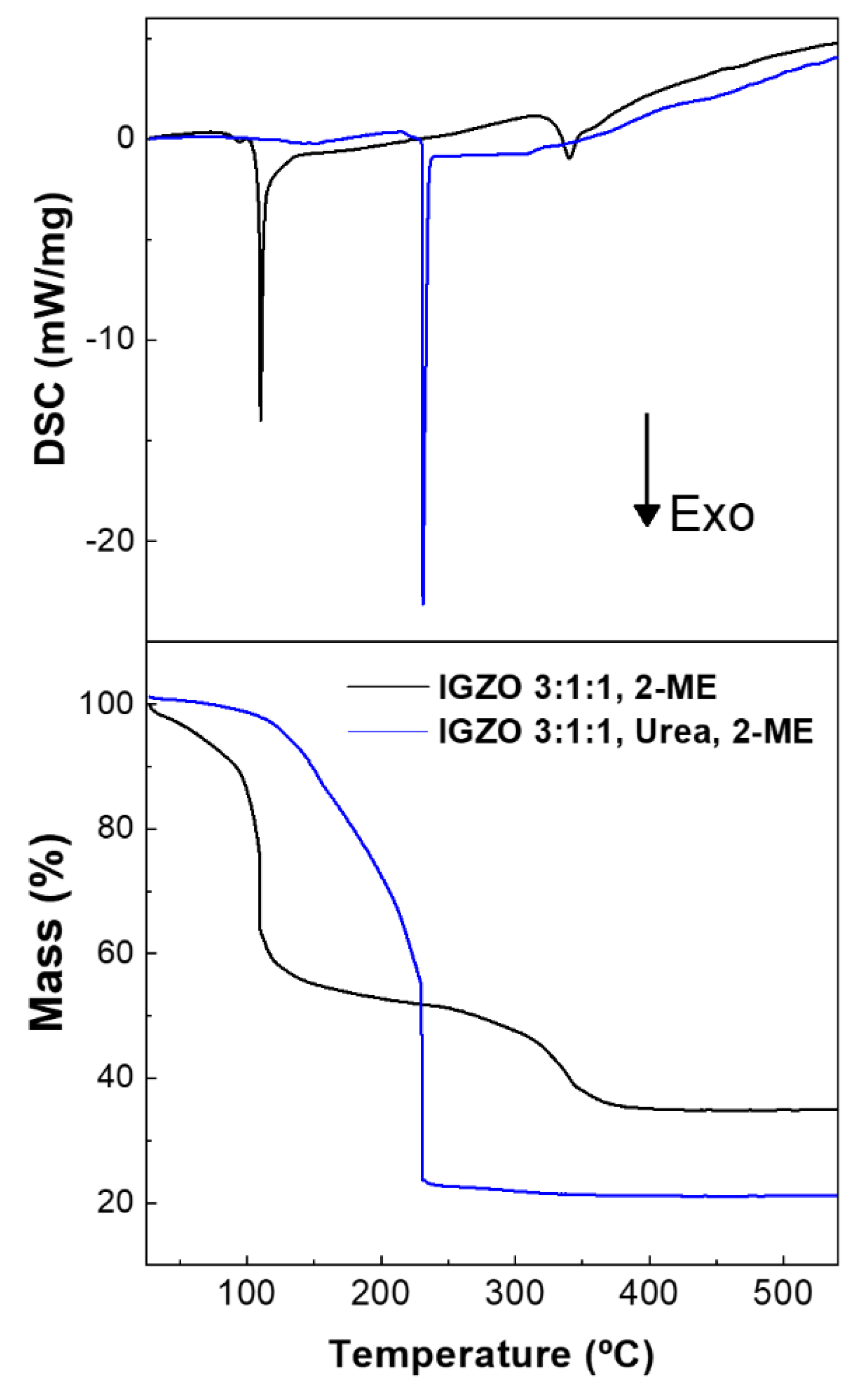
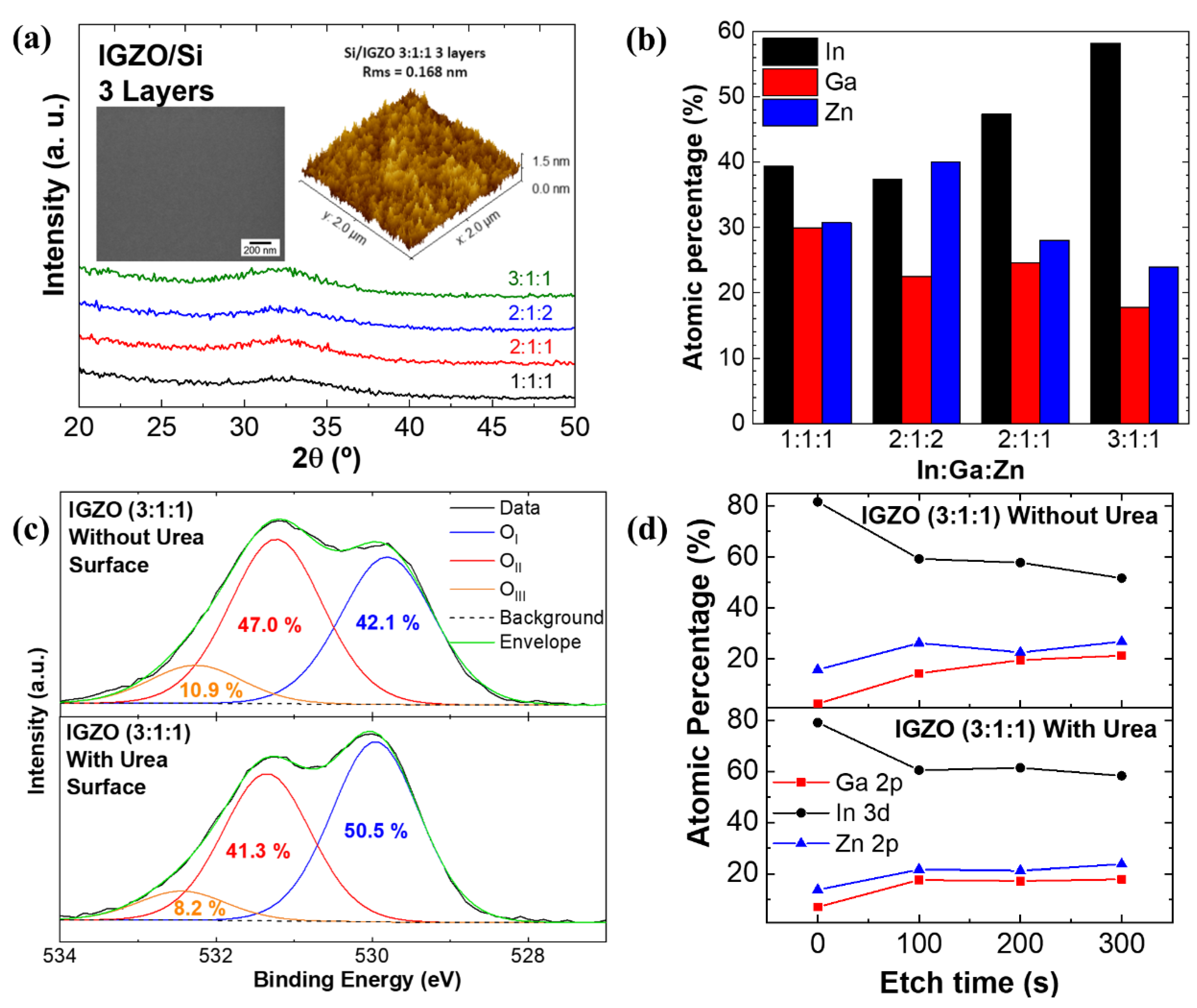
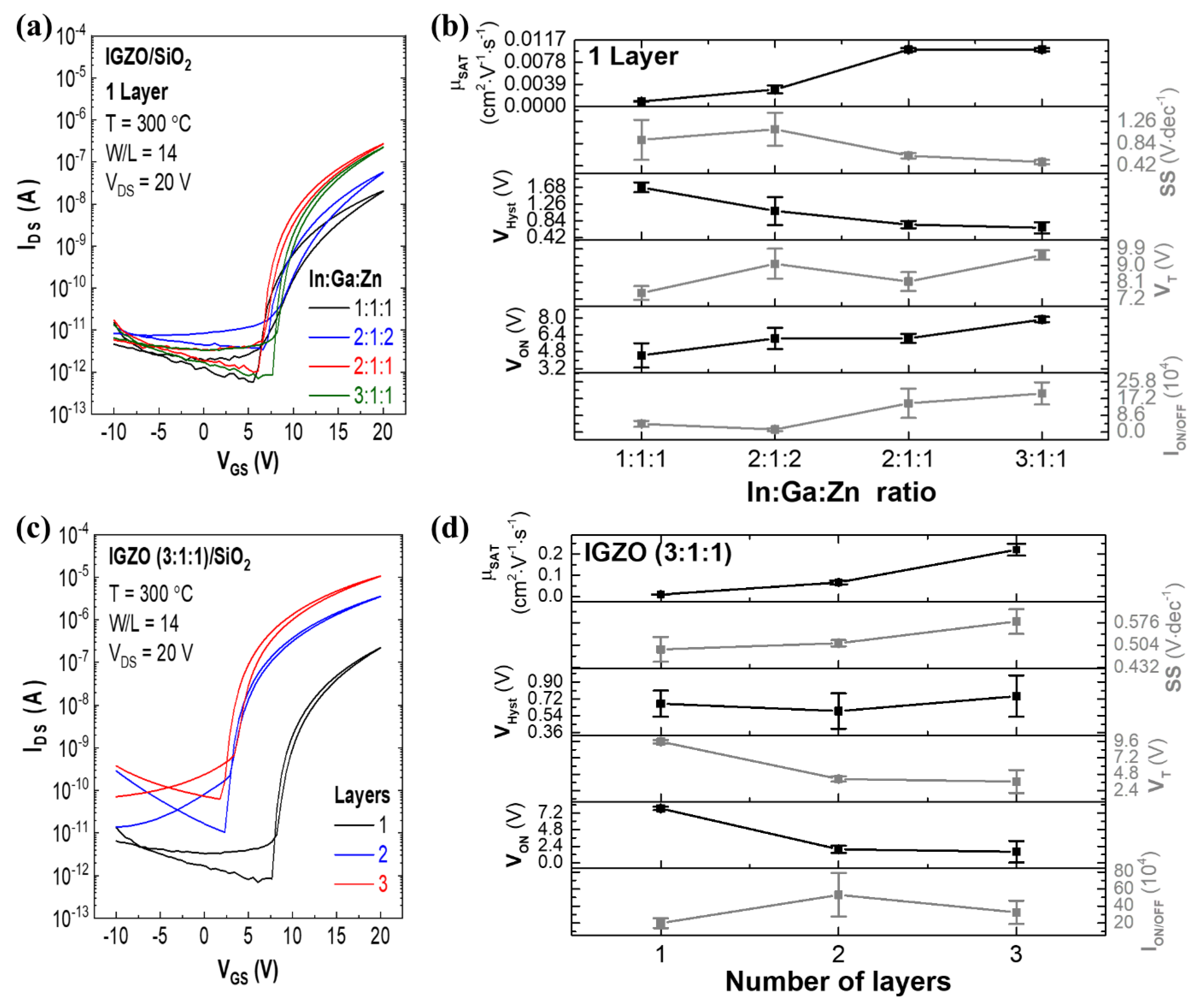
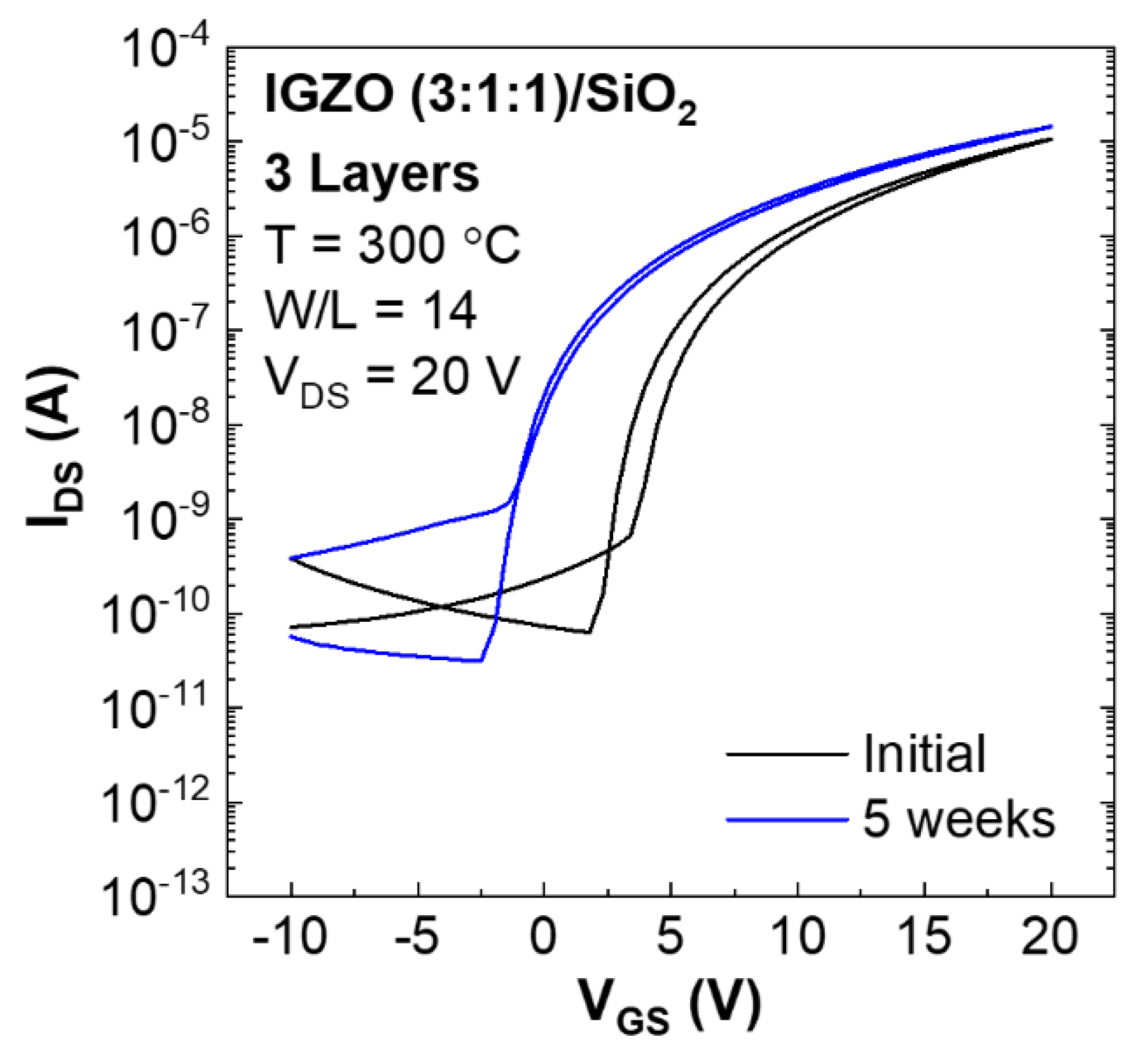
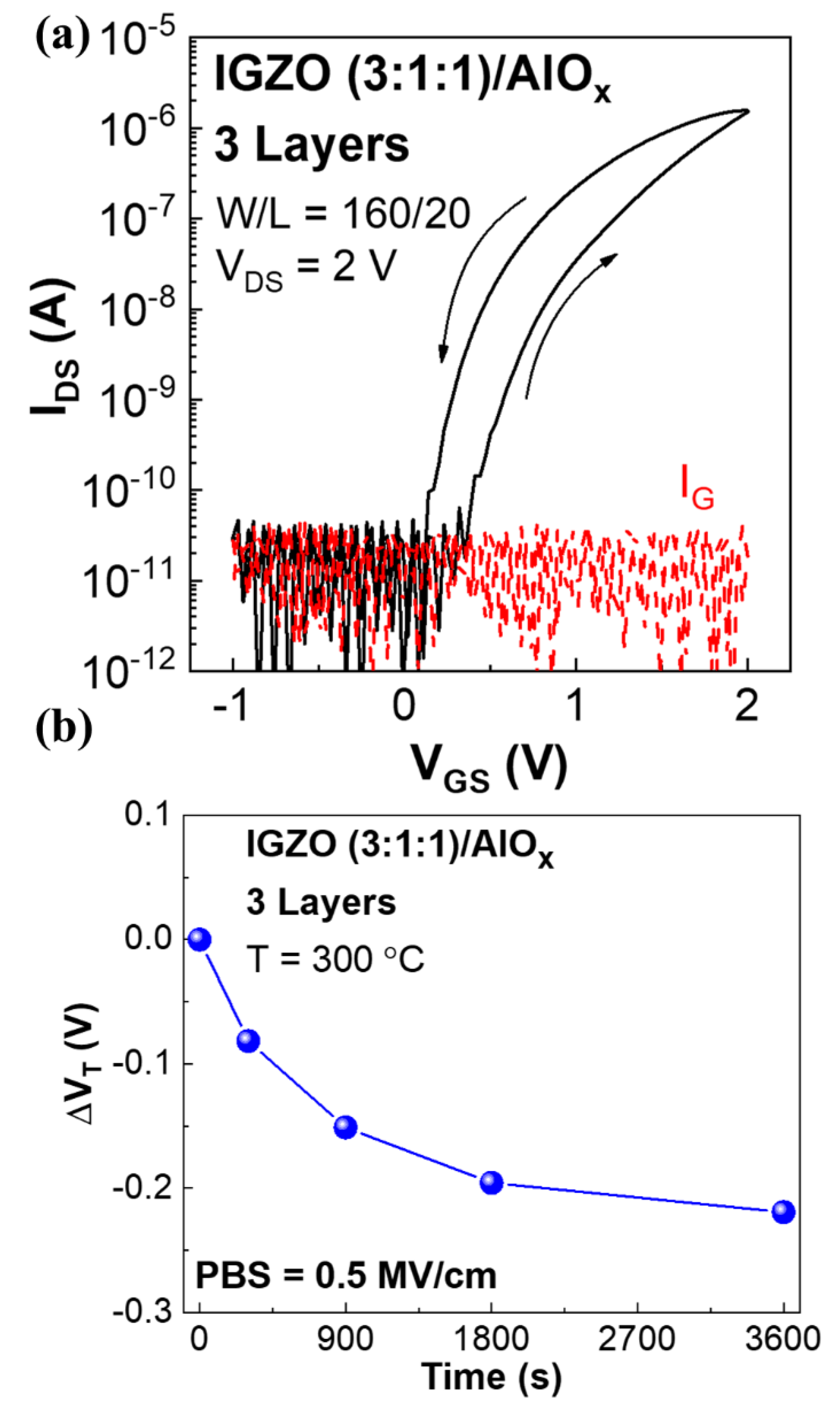
| Year | Fuel | Tmax (°C) | W/L | Dielectric (Technique) | In:Ga:Zn Ratio | µSAT (cm2/Vs) | SS (V/dec) | IOn/IOff | Von (V) | VGS (V) |
|---|---|---|---|---|---|---|---|---|---|---|
| 2008 [11] | No | 450 | 1000/150 | SiNx (PECVD) | 1:1:2 | 0.96 | 1.39 | 106 | ~5 | −15 to 55 |
| 2009 [12] | 400 | 1000/150 | SiNx (PVD) | 1:1:2 | 0.56 (μef) | 2.81 | 4.6 × 106 | 5 | −30 to 30 | |
| 3:1:2 | 0.90 (μef) | 1.16 | 3.8 × 106 | ~0 | ||||||
| 5:1:2 | 1.25 (μef) | 1.05 | 4.1 × 106 | −10 | ||||||
| 2009 [13] | 400 | 100/50 | SiO2 | 2:1:2 | 2 (μef) | - | 105 | - | −40 to 40 | |
| 2010 [14] | 400 | 1000/90 | ATO (ALD) | 3:1:1 | 5.8 (μlin) | 0.28 | 6 × 107 | ~0 | −10 to 30 | |
| 2010 [15] | 500 | 200/20 | SiO2 (Thermal oxidation) | 4:1:5 | 1.13 | 2.5 | - | - | −30 to 40 | |
| 2010 [7] | 450 | 1000/150 | SiNx | 3:1:2 | 0.86 (μlin) | 0.63 | 106 | ~0 | −30 to 30 | |
| 2010 [16] | 300 | 1000/100 | SiO2 | 63:10:27 | 0.2 | - | 105 | ~−15 | −40 to 40 | |
| 2011 [17] | 300 | 500/100 | SiO2 | 5:1:2 | 0.003 | 2.39 | 4.5 × 104 | - | −20 to 30 | |
| 2013 [18] | 300 | 1000/100 | SiO2 (Thermal oxidation) | 62:5:23 | 1.73 (μef) | 0.32 | 107 | 11 | −10 to 40 | |
| 2013 [19] | Yes (acac) | 300 | 5000/100 | SiO2 (Thermal Oxidation) | 80:10:10 | 5.43 | - | 108 | - | 0 to 100 |
| 2019 [20] | 300 | 1000/100 | SiO2 | 10:1:3 | 1.62 | 0.03 | 106 | ~0 | −40 to 80 | |
| 2019 [3] | No | 350 | n.d./100 | SiO2 | 68:10:22 | 0.72 | 0.68 | 106 | ~0 | −30 to 30 |
| This work | Yes (urea) | 300 | 160/20 | AlOx | 3:1:1 | 3.2 | 0.073 | 106 | 0.18 | −1 to 2 |
© 2019 by the authors. Licensee MDPI, Basel, Switzerland. This article is an open access article distributed under the terms and conditions of the Creative Commons Attribution (CC BY) license (http://creativecommons.org/licenses/by/4.0/).
Share and Cite
Moreira, M.; Carlos, E.; Dias, C.; Deuermeier, J.; Pereira, M.; Barquinha, P.; Branquinho, R.; Martins, R.; Fortunato, E. Tailoring IGZO Composition for Enhanced Fully Solution-Based Thin Film Transistors. Nanomaterials 2019, 9, 1273. https://doi.org/10.3390/nano9091273
Moreira M, Carlos E, Dias C, Deuermeier J, Pereira M, Barquinha P, Branquinho R, Martins R, Fortunato E. Tailoring IGZO Composition for Enhanced Fully Solution-Based Thin Film Transistors. Nanomaterials. 2019; 9(9):1273. https://doi.org/10.3390/nano9091273
Chicago/Turabian StyleMoreira, Marco, Emanuel Carlos, Carlos Dias, Jonas Deuermeier, Maria Pereira, Pedro Barquinha, Rita Branquinho, Rodrigo Martins, and Elvira Fortunato. 2019. "Tailoring IGZO Composition for Enhanced Fully Solution-Based Thin Film Transistors" Nanomaterials 9, no. 9: 1273. https://doi.org/10.3390/nano9091273
APA StyleMoreira, M., Carlos, E., Dias, C., Deuermeier, J., Pereira, M., Barquinha, P., Branquinho, R., Martins, R., & Fortunato, E. (2019). Tailoring IGZO Composition for Enhanced Fully Solution-Based Thin Film Transistors. Nanomaterials, 9(9), 1273. https://doi.org/10.3390/nano9091273









